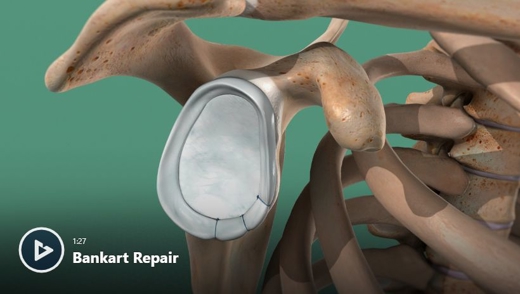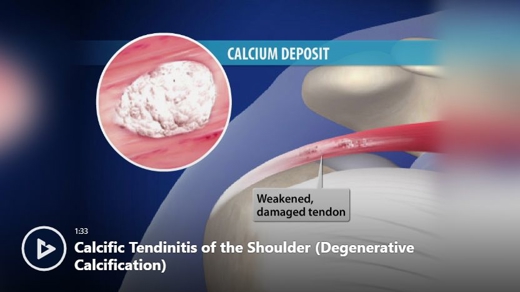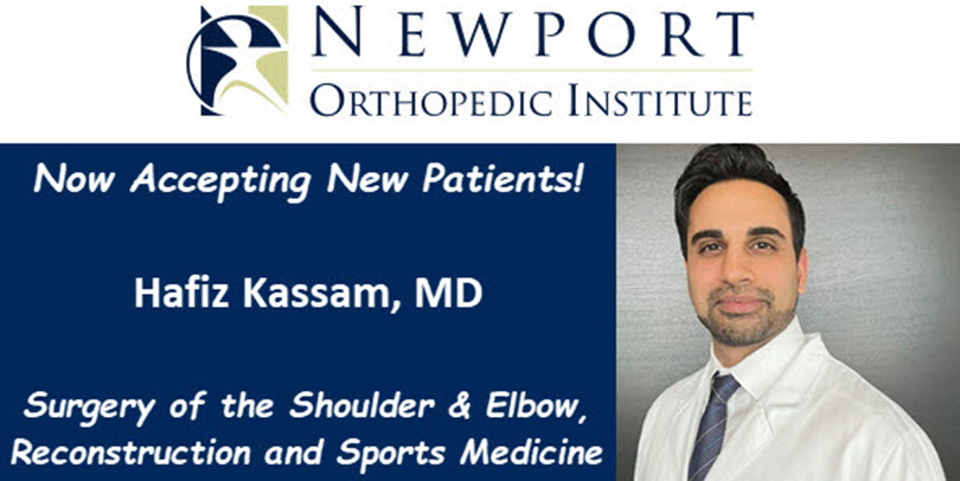
Rotator Cuff Tear
Expert Shoulder Surgeons in Orange County, CA
The Anatomy of the Rotator Cuff
Although there are many reasons for shoulder pain, a common problem for people over 40 years of age is a rotator cuff tear. The rotator cuff is comprised of the muscles and tendons that surround the top of the upper arm bone (humerus) and hold it in the shoulder joint. A tear may result suddenly from a single traumatic event or develop gradually because of repetitive overhead activities.
Causes of a Rotator Cuff Tear
Repetitive overhead motion such as pitching or painting a ceiling; heavy lifting; excessive force, such as a fall; and degeneration due to aging, including a reduction in the blood supply to the tendon can all lead to rotator cuff tears.
Rotator Cuff Tear Symptoms
Symptoms of rotator cuff tears include recurrent, constant pain; muscle weakness, especially when attempting to lift the arm; “grating” or cracking sounds when the arm is moved; and limited motion. Rotator cuff tears usually occur in the dominant arm (right shoulder for right-handed people; left shoulder for left-handed people).
Rotator Cuff Tear Treatment Options
Rotator cuff tears may be partial- or full-thickness. Partial-thickness tears do not completely sever the tendon and may respond well to non-operative treatments. Full-thickness tears require surgery to correct. Surgery may also be used to treat partial-thickness tears that do not respond to non-operative treatment.
Your doctor will prescribe a treatment regimen based on your injury and your need for pain relief, movement and function. In most cases, the initial treatment is non-surgical and will include non-steroidal anti-inflammatory medications or corticosteroid injections to help control pain; strengthening and stretching exercises as part of a physical therapy program; and good old-fashioned rest. Ultrasound can enhance the delivery of topically applied drugs and has thermal effects that may also help in the healing process.
Rotator Cuff Tear Surgical Treatment Options
There are several surgical options to treat rotator cuff tears, depending on the size, depth, and location of the tear. If other problems with the shoulder are discovered during the surgery, they will be corrected as well. Surgical options include:
- Arthroscopy, in which miniature instruments are inserted into small incisions, can be used to remove bone spurs or inflammatory portions of muscle and to repair lesser tears.
- A mini-open repair that combines arthroscopy and a small incision can be used to treat full-thickness tears.
- In more severe cases, open surgery is required to repair the injured tendon. Sometimes a tissue transfer or a tendon graft is used. Joint replacement is also an option.
It takes some time to recover from shoulder surgery. Full functioning may not return for six months or more. Your orthopedic surgeon will recommend a program of exercises to strengthen and restore motion. Your commitment to following the program outlined will make a difference in the ultimate results. Although every case is unique, surgery can relieve pain for most people and rehabilitation can restore functional range of motion.
Schedule a consultation with a Newport Orthopedic Institute orthopedic shoulder surgeon in Orange County to treat your rotator cuff tear arthritis. Call (949) 722-7038.
Our Rotator Cuff Tear Service Providers
-
 Hafiz F. Kassam MD
Hafiz F. Kassam MD- Orthopedic Surgery
View Profile -
 Russell S Petrie MD
Russell S Petrie MD- Orthopedic Surgery
View Profile -
 Myra Trivellas MDView Profile
Myra Trivellas MDView Profile -
 Emilia Ravski DO
Emilia Ravski DO- Sports Medicine (Non-Operative)
View Profile -
 Taylor R Dunphy MD
Taylor R Dunphy MD- Orthopedic Surgery
View Profile -
 Shaunak S Desai MD
Shaunak S Desai MD- Orthopedic Surgery
View Profile -
 James H Ting MD
James H Ting MD- Sports Medicine (Non-Operative)
View Profile -
 David S Gazzaniga MD
David S Gazzaniga MD- Orthopedic Surgery
View Profile
Where we provide Rotator Cuff Tear Services
-
 Hoag Orthopedic Institute Hospitals & Surgery Centers 16250 Sand Canyon Ave.
Hoag Orthopedic Institute Hospitals & Surgery Centers 16250 Sand Canyon Ave.
Irvine, CA 92618View Location -
 Hoag Orthopedic Institute Surgery Center - Newport Beach Hospitals & Surgery Centers 22 Corporate Plaza, Suite 150
Hoag Orthopedic Institute Surgery Center - Newport Beach Hospitals & Surgery Centers 22 Corporate Plaza, Suite 150
Newport Beach, CA 92660View Location -
 Newport Orthopedic Institute - Huntington Beach Orthopedics Physician Offices 19582 Beach Boulevard, Suite 306
Newport Orthopedic Institute - Huntington Beach Orthopedics Physician Offices 19582 Beach Boulevard, Suite 306
Huntington Beach, CA 92648View Location -
 Newport Orthopedic Institute - Irvine Orthopedics Physician Offices 16300 Sand Canyon Ave, Suite 400
Newport Orthopedic Institute - Irvine Orthopedics Physician Offices 16300 Sand Canyon Ave, Suite 400
Irvine, CA 92618View Location -
 Newport Orthopedic Institute - Newport Beach Orthopedics Physician Offices 22 Corporate Plaza Drive
Newport Orthopedic Institute - Newport Beach Orthopedics Physician Offices 22 Corporate Plaza Drive
Newport Beach, CA 92660View Location -
 Newport Orthopedic Institute - San Clemente Orthopedics Physician Offices 993 Avenida Pico
Newport Orthopedic Institute - San Clemente Orthopedics Physician Offices 993 Avenida Pico
San Clemente, CA 92673View Location
Stories about our Rotator Cuff Tear Services
-
- Shoulder
Shoulder Replacement
Provider: Russell S Petrie MD“Time in explaining and listening” -
- Shoulder
Shoulder Scope With Reconstruction
Provider: Russell S Petrie MD“I just want to say thanks for every thing. God bless you Dr. Russell Petrie and all your team thank you very much.” -
- Shoulder
Shoulder Scope With Reconstruction
Provider: Russell S Petrie MD“Dr. Petrie and his staff are very nice and professional.” -
- Shoulder
Shoulder Replacement
Provider: Russell S Petrie MD“Dr. Petrie performed my first shoulder replacement & I had such good results would never consider another surgeon.” -
- Shoulder
Shoulder Replacement
Provider: Russell S Petrie MD“This has been a super easy surgery and recovery and Dr Petrie and Dr Karri gave me so much confidence!” -
- Shoulder
Shoulder Scope With Reconstruction
Provider: David S Gazzaniga MD“The genuine attention and personal care they provide is exceptional. I appreciate the kindness and patience they demonstrate to their patients.”
Related Videos
-
 Acromioclavicular (AC) Joint ArthritisWatch Video
Acromioclavicular (AC) Joint ArthritisWatch Video -
 Acromioclavicular (AC) Joint Separation RepairWatch Video
Acromioclavicular (AC) Joint Separation RepairWatch Video -
 Anatomy of the ShoulderWatch Video
Anatomy of the ShoulderWatch Video -
 Arthroscopic Capsular ReleaseWatch Video
Arthroscopic Capsular ReleaseWatch Video -
 Bankart RepairWatch Video
Bankart RepairWatch Video -
 Biceps Tendon Tear (at the Shoulder)Watch Video
Biceps Tendon Tear (at the Shoulder)Watch Video -
 Biceps TendonitisWatch Video
Biceps TendonitisWatch Video -
 Burners and StingersWatch Video
Burners and StingersWatch Video -
 Bursitis of the Shoulder (Subacromial Bursitis)Watch Video
Bursitis of the Shoulder (Subacromial Bursitis)Watch Video -
 Calcific Tendinitis of the Shoulder (Degenerative Calcification)Watch Video
Calcific Tendinitis of the Shoulder (Degenerative Calcification)Watch Video
Blogs about Rotator Cuff Tear Services and Care
-
 Hafiz Kassam, M.D. Receives the Nation’s Highest Award for Clinical Science in Shoulder & Elbow Surgery
Hafiz Kassam, M.D. Receives the Nation’s Highest Award for Clinical Science in Shoulder & Elbow SurgeryHafiz Kassam, M.D., orthopedic surgeon and Director of the Shoulder Reconstruction Division at Hoag Orthopedic Institute, has been awarded the Charles ...
Read More -
 Introducing Hafiz Kassam, M.D., Now Accepting New Patients!
Introducing Hafiz Kassam, M.D., Now Accepting New Patients!Newport Orthopedic Institute is pleased to welcome Dr. Hafiz Kassam to our team. Dr. Kassam is a board-certified orthopedic surgeon who is ...
Read More


